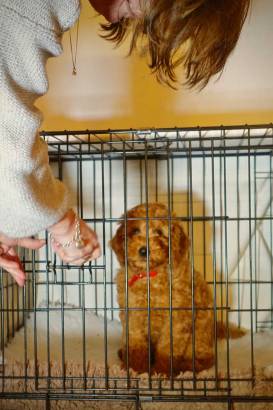The very first few nights with a new puppy can be a daunting experience for both the puppy and you as a new owner wanting to do the very best for your dog and to give them an emotionally and physically secure start.
From the puppy’s perspective, leaving the litter and coming into a strange environment can be a traumatic experience, but over the coming days and nights a puppy will quickly adjust to its new surroundings in the knowledge that all its needs are being met in the new home, such as food, warmth, play and the bond that is being created with the new family.
The essence of the video I have created on this subject looks at ways in which we can create a positive environment for the puppy to sleep at night and for the owner to get a good night’s rest in readiness to do the puppy routine all over again the following day. It’s fair to say that many of the calls or emails I receive from new puppy owners are for this particular problem (a puppy that isn’t sleeping well at night) and that with a few tweaks it can usually be resolved over a period of time.
So to elaborate a little, we have a puppy that is with you throughout the day and naturally will want to keep you in its sights and to watch the comings and goings, and then at night the puppy is placed in the crate and has to cope with alone, whilst in darkness. Your puppy may have a different idea as to what should happen at night!
Puppy crying at night
A puppy can be surprisingly noisy in these first few nights and can quickly lead to the owner becoming sleep deprived. This, in turn, can lead to desperation and the owner may inevitably find that the pup will quickly settle as soon as it is in the bedroom with the owner, or another common response from desperate owners is to go downstairs and to sleep alongside the puppy on the sofa or camp bed. Whilst I accept that this is placating the puppy and that the pup can sleep and so can the owner, this is not addressing the issue, which is getting the puppy to learn to sleep alone in a dark, quiet room. Tackling this issue now when the puppy is more open to new experiences, will be a great deal easier than addressing it later.
Dogs in the bedroom - Not the best idea
Is it really such a problem for you to have your dog in the bedroom at night in order to get a good night’s rest? On the face of it, no, but this is not what I would consider being the best arrangement from the outset. With a young dog, we are looking to create a relationship that is balanced and based on common sense rules in and out of the home. With puppies, we are also looking ahead on the basis of problem avoidance later on.
Now, with my dog behaviour problem hat on, many of the cases I see in homes where the dog is being possessive, protective, cannot leave the owner’s side (separation anxiety) aggression to the owner or other dogs, I will often (not always, but often) find that the dog has to be right next to the owner and this includes at night. I’m not saying that if you allow your dog to sleep in your room you will definitely have problems, but I do see a correlation in my work and often have to look at ways in which we can unpick this when the dog is older - which is much more of a challenge to deal with at 12 months than it is at 2-3 months. So I am thinking of ‘best practice’ as I can offer you, the first time dog owner let’s say, the benefit of my experience and this is why I take a relatively dry approach to the puppy arrangement at night. There are of course many dogs that sleep in the same room as their owner from day one and the dog is perfectly well balanced and free from behaviour problems, but remember, this is about doing everything you can to ensure you have a balanced dog from the outset, regardless of what others do.
A quiet puppy at night
In a nutshell, my advice is to place your dog in the crate at bedtime, to lock the door of the crate and NOT to come back until a sensible hour in the morning, whereby you let the dog out. This is good in theory, but the approach needs to be padded out somewhat so that you move a number of factors in your favour to help ensure a calm and quiet night for your puppy. Let’s look at what things you can do in the day and early evening to help set you and the puppy up for a quiet night, whereupon rising you are fit to look after a demanding puppy (because if you didn’t know already, new puppies can be hard work - numerous owners have told me their own child was easier than the puppy!).
Puppy exercise - How I do it
Given that we’re looking at the very first few days and weeks in the puppy owning process, you won’t be formally taking your dog out to be exercised as you would an older dognap so this is not quite how you would deplete energy in a puppy, but puppies really can have a great deal of physical and mental energy that needs to be sensibly drained each day and there are still avenues available to you to do just this. As you will see in the video relating to first walks and socialisation, we have taken Ruby out every day from day one in the car and then onto walks with our two existing dogs, Max and Pip. She was carried in a puppy body sling identical to this one found on Amazon and was allowed to absorb all of the sights, sounds and smells in a variety of different locations each day.
This alone is really quite tiring for an 8 week old plus puppy, as it’s a big sensory input but in the safety of her sling and our family. We also put her down on the forest floor in various locations and allow her to sniff and a bit of a romp with Max and Pip. You are likely to know when your puppy has had enough messing about on the floor when it starts to sit or lie down. Remember, you are not looking to exercise your pup in the traditional sense, but to offer it the chance to explore by sniffing, a bit of charging about without a particular structure and to blow off some of that steam so that things will be calmer and more manageable in the home and rest periods are likely to be more forthcoming.
Whilst she is still processing her vaccinations, we feel that the benefits of gaining these social experiences and being allowed to move in open, public space far outweigh any of the risks that may be present. The locations we use would be ‘low risk’ and as such are away from car parks or heavy dog traffic areas where you might expect to encounter dog waste.
Mental activity for your puppy
So the above two paragraphs begins to look at ways in which you can allow your puppy some physical and mental energy expenditure each day and I have been to many homes where the puppy is going bonkers due to a lack of this and so we need to think about ways in which outlets can be provided to the dog. Other traditional ideas are to provide small Kongs and toys such as the ones I list in the first video in this series and can be seen here. Little Ruby loves all of her toys and is really quite playful. Some dogs can be less so, so your mileage may vary. We feed Ruby Forthglade dog food and so this works well to be placed inside a puppy Kong as it is soft and sticky. She needs a little help still, but this will keep her busy for a while.
Positive associations to the crate for your puppy
As the evening approaches, your puppy may have a number of highs and lows in terms of energy. They tend to be really quite active and then curl up and crash, this is normal and to be expected. Avoid placing your dog in the crate for long periods in the day. Daytime sleeps in the crate are to be encouraged, as well as feeding all meals in the crate as this can create positive associations to the crate itself. About an hour before her expected bedtime (for us that’s anytime between 10 and 11 pm) we remove access to water so that she will not be going into the crate with a full bladder. Give the last toilet break and then move to the bedtime routine as I set out below. We would also avoid getting her overly excited in the lead up to her bedtime. Interactions should be calming, not excitable prior to bedtime. The crate I use can be found here on Amazon.
A calm goodnight to your puppy
When you physically place your puppy into the crate, remove any water, toys and her collar for safety. I find that Ruby settles better if I kneel down and get her to lie down and to soothe her into the mind of being left and sleep. Only a minute or two of this, as much more would just turn into a long goodbye. I tell her to ‘Stay’ and then close the door. We have found that she settles more quickly when covering her crate with a light sheet so as to create a den feeling and it also increases her sleep into the morning, although December nights are in our favour in the respect. Ensure your puppy is not too hot or too cold in the location you choose.
Ensuring you get your sleep
So that’s it. You go to bed and use some decent earplugs - I recommend and use these from Amazon. They improve my sleep in any event and I’ve been using them for years, but they come into their own when you have a puppy! There is no point in you lying in bed listening to your puppy cry and howl - and you may experience all of that. You need to sleep and sleep well, ready to be on your toes for puppy care or work the next day. Your puppy will be fine and can sleep off any lack of sleep in the day; you are unlikely to have that luxury!
Planning ahead with your puppy
What time you come down to your puppy depends on your lifestyle, but you’re likely to need to give yourself extra time in the morning to feed, toilet, garden exercise and play with your puppy a little before you do the school run, or go to work or whatever the day holds for you. We have been fortunate with Ruby and she has been waking and then calling us down at about 07:30 if not a little later, which has been a pleasant surprise.
Try to create a consistent pattern for bedtime and waking times as this will help your puppy get into a rhythm. You can expect anything between 3-10 days of noisy nights (especially when you first leave your puppy when going to bed). It will stop, so bear with it. If you get the toileting and water control right on the lead up to bedtime, you should have the minimum of accidents in the crate.
In the daytime, be aware of your puppy following you like a shadow and try to prevent this by issuing a 'Stay' command and closing the door behind you as you go. If this behaviour is indulged, you can create a dog that is overly dependent upon you and you may well find it cannot cope when left alone for sensible periods of time.








